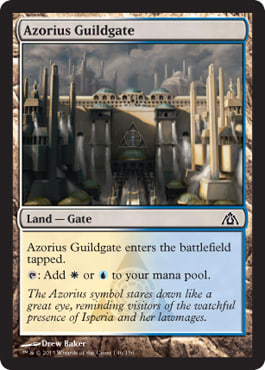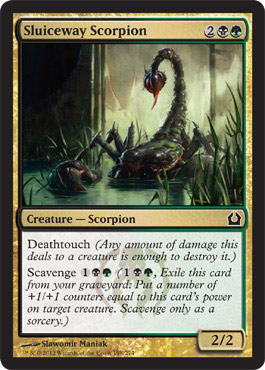Fast-forward to Innistrad, where I was lucky enough to rediscover the game. The Sealed prerelease was my first introduction to Limited play, and I was instantly hooked. A few months later, Zac Hill wrote the preview article for Cavern of Souls that made me realize Standard was not the format for me, and all of a sudden, my Magic attention was focused almost entirely on drafting. What I can offer is my earnest attempt to become the best Limited player I can be, and I look forward to learning from your inevitably awesome and insightful comments.
With that out of the way, let’s move on to today’s topic: Building mana bases in a multicolored block. Given the sets currently being drafted (Dragon's Maze-Gatecrash-Return to Ravnica, or DGR) this seems to be a reasonable skill to develop early in the format. Let’s take a look at a deck I drafted at one of my local shops:
"DGR B/U/G Draft Pile"
- Creatures (15)
- 1 Balustrade Spy
- 1 Beetleform Mage
- 1 Frilled Oculus
- 1 Golgari Longlegs
- 1 Kraul Warrior
- 1 Leyline Phantom
- 1 Opal Lake Gatekeepers
- 1 Slum Reaper
- 1 Woodlot Crawler
- 1 Zameck Guildmage
- 2 Ubul Sar Gatekeepers
- 3 Voidwielder
- Spells (8)
- 1 Dimir Charm
- 1 Far // Away
- 1 Psychic Strike
- 1 Putrefy
- 1 Assassin's Strike
- 1 Urban Evolution
- 1 Krasis Incubation
- 1 Dimir Cluestone
- Lands (3)
- 1 Dimir Guildgate
- 1 Golgari Guildgate
- 1 Simic Guildgate
Here, we have a straightforward B/U/G list with no splash and some decent fixing. When building a mana base, our first step is to count the colored mana symbols on each of our cards. During this step of the process, we don’t count activation costs—only casting costs. Doing this, we arrive with the following:
| Color | Symbols |
|---|---|
| 14 | |
| 12 | |
| 7 |
In this case, we have counted Golgari Longlegs as one each of black and green mana symbols, but there are times when it is right to count hybrid cards solidly in one color or another—it just depends on the context (more on this below). The next step when building a mana base is to count the color sources on the mana fixing we drafted—in this case, that would be three Guildgates and a Cluestone. This gives us:
| Color | Symbols | Fixing |
|---|---|---|
| 14 | 3 | |
| 12 | 3 | |
| 7 | 2 |
This deck has no 7- or 8-drops, so there is no reason to run eighteen lands. We are running the Cluestone in addition to our seventeen lands because it fixes our mana and can be cashed in later for a card. This means we have fourteen basic land slots for our deck. Based on the proportion of the colored mana symbols, this implies a mana base that looks like this:
| Color | Symbols | Fixing | Basics | Sources |
|---|---|---|---|---|
| 14 | 3 | 6 | 9 | |
| 12 | 3 | 5 | 8 | |
| 7 | 2 | 3 | 5 |
However, I don’t believe we’re quite in the sweet spot yet. Although it would be great to play nine sources of ![]() , note that many of our early drops require
, note that many of our early drops require ![]() , particularly Kraul Warrior, Zameck Guildmage, and Beetleform Mage. Additionally, Frilled Oculus, Beetleform Mage, and Zameck Guildmage have activated abilities that require
, particularly Kraul Warrior, Zameck Guildmage, and Beetleform Mage. Additionally, Frilled Oculus, Beetleform Mage, and Zameck Guildmage have activated abilities that require ![]() . For these reasons, I think it’s correct to cut an Island and add a Forest. This leaves us with this:
. For these reasons, I think it’s correct to cut an Island and add a Forest. This leaves us with this:
| Color | Symbols | Fixing | Basics | Sources |
|---|---|---|---|---|
| 14 | 3 | 5 | 8 | |
| 12 | 3 | 5 | 8 | |
| 7 | 2 | 4 | 6 |
Eight is the minimum number of sources I would ever play for a main color, so shaving a Swamp was not the correct option here. Nine sources of ![]() would have been nice, but this mix of colors gives us the best shot to play all of our spells in any given game.
would have been nice, but this mix of colors gives us the best shot to play all of our spells in any given game.
Here’s another deck I drafted with the completed mana-base chart below:
"DGR R/W/U Draft Pile"
- Creatures (13)
- 1 Basilica Guards
- 1 Blaze Commando
- 1 Fencing Ace
- 1 Frostburn Weird
- 1 Izzet Staticaster
- 1 Keymaster Rogue
- 1 Maze Glider
- 1 Metropolis Sprite
- 1 Wind Drake
- 2 Opal Lake Gatekeepers
- 2 Vassal Soul
- Spells (10)
- 1 Avenging Arrow
- 1 Azorius Charm
- 1 Protect // Serve
- 1 Renounce the Guilds
- 1 Turn // Burn
- 1 Warleader's Helix
- 1 Knight Watch
- 1 Blind Obedience
- 1 Pursuit of Flight
- 1 Prophetic Prism
- Lands (3)
- 1 Azorius Guildgate
- 1 Boros Guildgate
- 1 Izzet Guildgate
| Color | Symbols | Fixing | Basics | Sources |
|---|---|---|---|---|
| 12 | 3 | 6 | 9 | |
| 14 | 3 | 5 | 8 | |
| 5 | 3 | 3 | 6 |
As far as color proportion goes, this deck is very similar to the previous one. I bring it up because I want to point out how I counted the hybrid mana symbols, particularly with Frostburn Weird. In this case, blue is our main color, and red is our splash color. With Frostburn Weird as a 2-drop, I chose to count it as a mono-blue card—the option to use red is just a bonus. With the two Vassal Souls, however, I counted a blue and a white mana for each since these are my main colors and I’d like to keep the proportion relatively even between the two.
Again, it’s all about context—when do you want to play the card in question? Is it a hybrid in your two main colors, one main color and a splash, or do you not have the second color available at all in your deck? Will the card be effective late-game or is it important to play it early? If I had counted Frostburn Weird as one of each color, there’s a chance I would have ended up with an extra Mountain and one fewer Island, and that would have hurt the deck’s consistency.
Let’s take a look at one last deck with a more complex mana base:
"DGR Five-Color Draft Pile"
- Creatures (16)
- 1 Crocanura
- 1 Deputy of Acquittals
- 1 Drakewing Krasis
- 1 Elusive Krasis
- 1 Haunter of Nightveil
- 1 Isperia's Skywatch
- 1 Korozda Guildmage
- 1 Leyline Phantom
- 1 Nimbus Swimmer
- 1 Risen Sanctuary
- 1 Scab-Clan Charger
- 2 Centaur Healer
- 2 Saruli Gatekeepers
- 1 Ruric Thar, the Unbowed
- Spells (6)
- 1 Pit Fight
- 1 Trostani's Judgment
- 1 Beck // Call
- 1 Dreadbore
- 1 Urban Evolution
- 1 Golgari Cluestone
- Lands (6)
- 1 Azorius Guildgate
- 1 Gruul Guildgate
- 1 Rakdos Guildgate
- 1 Sacred Foundry
- 1 Selesnya Guildgate
- 1 Simic Guildgate
We have a five-color deck! Doing our color inventory shows us that we are mainly Bant, leaning Simic, with just splashes of black and red. Luckily, we have quite a bit of fixing to assist with all the greediness:
| Color | Symbols | Fixing |
|---|---|---|
| 6 | 3 | |
| 10 | 2 | |
| 3 | 2 | |
| 2 | 3 | |
| 15 | 4 |
So far, so good. It’s nice to see that we don’t need to worry about any more red sources. Between Gruul Guildgate, Rakdos Guildgate, and Sacred Foundry, we should easily be able to cast Ruric Thar, the Unbowed by late game. Dreadbore will be difficult to cast early, but unconditional removal is powerful at any point in the game, so we’re not really depending on playing it early anyway.
The other four colors are going to need some assistance, however. With six nonbasic lands in the deck, this leaves us space for eleven or twelve basics to fill out our mana base. Because we are playing a deck that not only features sweet 6-, 7-, and 8-drops, but also requires all five colors, we are going to play eighteen lands plus our Cluestone.
As green is our main color, we absolutely need at least eight sources in the deck. Adding a ninth source would be great, but we have four other colors to worry about and not a lot of space for basics. Blue is the next most demanding color, but besides the two Krasises, most of our blue spells are mid- to late-game plays. As such, we’re going to skimp just a bit on blue and end up with only seven total sources, adding five Islands to our nonbasics. This leaves us with only three lands to divvy up between white and black. White is much more demanding than black, so we’ll go with two Plains and one Swamp. The last phase of our chart looks like this:
| Color | Symbols | Fixing | Basics | Sources |
|---|---|---|---|---|
| 6 | 3 | 2 | 5 | |
| 10 | 2 | 5 | 7 | |
| 3 | 2 | 1 | 3 | |
| 2 | 3 | 0 | 3 | |
| 15 | 4 | 4 | 8 |
This isn’t the smooth and ideal mana base we’re hoping to see, but five-color decks are all about sacrificing consistency for raw power. When playing a deck like this, it is important to mulligan hands that have only one or two colors available or have no castable cards. There’s not a lot we can do to control our draw steps, but there’s a ton we can do to influence how the game begins: Ship bad hands until we see something playable.
The Gatekeepers cycle creates some interesting tension in deck-building. These were our pertinent sideboard cards:
- Selesnya Sentry
- Knight Watch
- Eyes in the Skies
- Rootborn Defenses
- Ogre Jailbreaker
- Sluiceway Scorpion
- Zhur-Taa Swine
- Tenement Crasher
We easily could have cut one or both of our splashes, making the deck more consistent but less powerful. The reason I decided against conservatism was due to the two Saruli Gatekeepers. Cutting colors would have meant cutting Guildgates, which would have lowered the chances of the Gatekeepers providing extra value. (I refuse to run an off-color Guildgate except in the most extreme circumstances.) As it was, I decided that between the two Centaur Healers and two Saruli Gatekeepers, I could survive playing a less consistent deck because aggressive opponents would have to do around 30 points of damage to finish me off.
Building mana bases in a multicolored format can be challenging, but doing so correctly can help us have a leg up on the competition. And it sure is a great feeling to play two Guildgates followed by a basic land and have all five colors up on turn three. As I continue to draft the format, I will explore many of the other early questions I’ve had: What is the optimal mix of lands to Cluestones? How many Gates do I need to start picking Gatekeepers? Or can we prioritize Gatekeepers and grab Gates later? Are two-colored decks a thing? I will also continue to read articles, watch Draft videos, and tune in to Twitch.tv to learn as much as I can about the format. There are a lot of people working to solve DGR, and we don’t each need to reinvent the wheel.
If you enjoyed my article, or use a different technique for building mana bases, please share it in the comments!

























